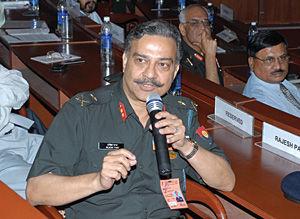INDIAN ARMED FORCES CHIEFS ON
OUR RELENTLESS AND FOCUSED PUBLISHING EFFORTS

SP Guide Publications puts forth a well compiled articulation of issues, pursuits and accomplishments of the Indian Army, over the years

I am confident that SP Guide Publications would continue to inform, inspire and influence.

My compliments to SP Guide Publications for informative and credible reportage on contemporary aerospace issues over the past six decades.
- Prime Minister witnesses 'Bharat Shakti' – a Tri-Services Firing and Manoeuvre Exercise in Pokhran, Rajasthan
- Interim Defence Budget 2024-25 — An Analysis
- Union Defence budget 2024
- Prime Minister Modi Commemorates Indian Navy Day in a Grand Ceremony
- Prime Minister Modi Flies in the LCA Tejas
- New Chapter in India-Italy Defence Ties
- Airpower beyond Boundaries
Network Centric Warfare is a “key enabler”: Seminar

There is a groundswell of support among the higher echelons of power for speedy deployment of network centric warfare (NCW) systems, borne out of a robust homegrown network. At a seminar on “NCW in the Indian Context”, organised jointly by SP Guide Publications and the Centre for Land Warfare Studies (CLAWS), eminent speakers, including Dr V.K. Saraswat, Scientific Adviser to the Defence Minister; Lt General N.B. Singh, Director General Information Systems; Lt General P. Mohapatra, Signal Officer-in-Chief and others were unanimous on how NCW would be a “key enabler” in the emerging battlefield scenario.
The Scientific Adviser who inaugurated the well-attended seminar, set the tone by stating that NCW is evolutionary and that it should be treated as ‘an enabler and not as the main tool’. A force with NCW capability will easily transform itself to a seamless, network-enabled information age force. Information advantage provides a decisive warfighting advantage, with its shared battle-awareness, speed of command and rapid knockout capability. NCW is based on a network and the nation is on course to deploy the next generation network (NGN).
Mentioning how different technologies such as satellite communication; mobile ad hoc network; active array digital radars etc had been deployed, Dr Saraswat underlined the importance of security architecture in all the technologies.
Dr Saraswat released the latest issue of SP’s MAI, a fortnightly which addresses security concerns.
Brigadier (Retd) Gurmeet Kanwal, Director, CLAWS, welcomed the gathering.
The Chairman and Managing Director of SP Guide Publications, Jayant Baranwal, in his vote of thanks, underscored the importance of NCW in the emerging threat scenarios in India.
Security Concerns
In the session on NCW and the Indian Armed Forces: Present Status and Concerns, Lt General N.B. Singh stated that the Indian Army had embarked upon NCW and was factoring risk-mitigation strategies. Mentioning how import of electronic equipment, particularly from “our adversaries” increased security risks, he said one of the adversaries (referring to the Chinese) had over 4,00,000 hackers and “we have to be prepared for this”.
Major General (Retd) D.V. Kalra, former ADG IS said NCW increased intelligence and surveillance capabilities; enhanced weapon deployment (increased lethality) and seamlessness. With NCW the means of surveillance and the means of engagement had become decisive.
Colonel K.P.M. Das of Cisco said the procurement conundrum would continue in India and one had to be prepared to the delayed introduction of tactical communications system (TCS). As for NCW, he drew an analogy with football where it is not just a technology-game but a mind-game as well. He mentioned that over 90 per cent of C4ISR platforms were on Cisco.
Brigadier L.B. Chand, Deputy Assistant Chief of Integrated Defence Staff (DAC IDS) dwelled on tri-services effects-based operations (EBO) and how it incorporated the behavioural element (political, economic and cultural), but for this it was as good as netcentric operations. Giving the example of EBO, first deployed on January 17, 1991 in Iraq, he said the operations worked simultaneously, paralysing different elements of the opponents.
In the session on ‘Future Prospects and Challenges for NCW’, Lt General (Retd) V.K. Kapoor and Editor of SP Guide Publications, who chaired the session, said with nuclear deterrence in the region, the likelihood of a large-scale war is limited, but there would be other disturbances/skirmishes. These forces need to get ready and NCW would substantially assist in their operations. “Think big with smaller forces,” he quipped.
Air Vice Marshal (Retd) D.N. Ganesh said network centric operations would entail global awareness; global tools and communication and global decision-making (as it will be transparent). However, he cautioned that there were perils of emulating the US example.
warfare had assumed dangerous dimensions. Even networks such as that of the army are not threat-proof and with the opening up of networks, the threat potential was increasing.
Wing Commander (Retd) Arif Khan of Ericsson talked about leveraging COTS (commercial off the shelf) technologies from the civilian domain to the military domain through customisation.
Valedictory Session
Lt General P. Mohapatra, Signal Officer-in-Chief, said net centricity is not a goal in itself and that it is ever evolving. “It is about networking,” he said and cautioned that there was possibility of information overload which would reduce the speed of decision-making. This had to be guarded against. On interoperability between the tri-services, he said if a network is in place, it would be a great driver for jointness. “Once the defence communication network is there, it would bring about triservices integration.”





